You either love them or hate them, but I find the flat felled seam to be one of the best that you can sew if you need a strong enclosed seam. They’re also a great way to add top-stitching detail to a hand sewn garment too.
If you’re looking for other seam types, do check out these seam tutorials:
• French seam
• Welt seam
• Lapped seam
• Open seam
• Mock French seam
And scroll to the bottom if you’d prefer to see a video showing the flat felled seam sewing process!
What Do You Need To Sew Flat Felled Seams?
To practice sewing a felled seam, you will want to gather the following supplies:
- Sewing machine
- Regular presser foot or flat felled foot
- Thread
- Bobbin
- Two pieces of fabric
- Fabric scissors
- Dressmaking pins
- Tape measure
- An iron
How Do You Make A Flat Felled Seam?

There are two ways to sew a flat felled seam and the way each is constructed defines its technical name.
Flat Felled Vs Run And Fell
Want to know quickly what the differences are? The flat felled is always used for outerwear and denim, and the run and fell seam is used on shirts.
If you’ve ever looked very closely at denim wear (that has real and not mock felled seams) and a well made tailored shirt you’ll have notice that both have enclosed seams.
Here’s a photo of a true flat felled seam on my favourite and knackered old Levis jacket.
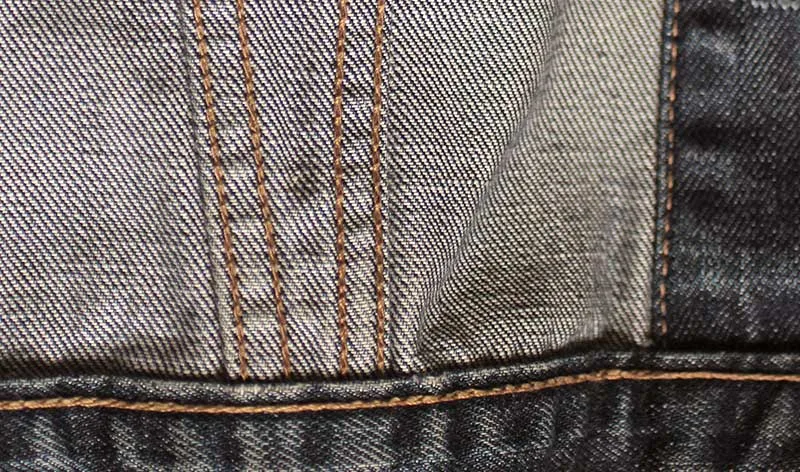
And here’s a photo of the seam on a tailored silk shirt.
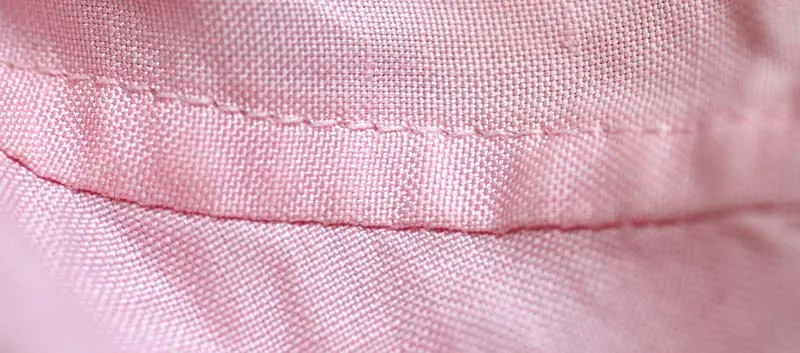
Can you see the obvious difference?
The denim seam – aka flat felled seam – has two lines of stitching. This is the version which is sewn with wrong sides together.
The silk shirt version – aka run and fell seam – has only one visible line of stitching, and is sewn as normal with right sides together.
Let’s jump into the flat felled seam tutorial first!
Sewing A Flat Felled Seam
I want to start by saying that in the fashion industry, there is no trimming away of fabric when sewing a flat felled seam. Patterns are always created with the actual seam allowance amounts needed on each side of the seam, and the raw edge is enclosed.
One pattern piece will have a wider seam allowance, and the joining pattern piece will have a more narrow seam allowance amount.
These amounts are marked with notches, and help the sample machinist to line up the fabric pieces in the correct places.
For ease, and to simplify the process for home sewers, I’m showing you the easier method of using a the same seam allowance on both sides which will result in a trimmed seam allowance.
7 Steps To Sew A Flat Felled Seam
- Take two pieces of cloth, and place them wrong sides together, pinning to secure.
- Place the fabric pieces under the sewing machine foot, and sew with your chosen amount of seam allowance.
- Press the seam with an iron and press cloth if needed.
- Open the seam, and press both seam allowance sections in the same direction.
- Take your fabric scissors and trim the seam allowance that is underneath, to just under half.
- Fold the top seam allowance amount under the bottom seam allowance amount, ‘enclosing’ it to created a folded edge. Make sure the width is consistent. You can press in place and then secure in place with your pins if needed.
- Place the fabric back under the sewing machine foot, and now edge stitch along the folded edge removing the pins as you go.
You’ll notice that the seam has two visible lines of stitching on the right side, and only one on the reverse / wrong side. This is a flat felled seam!
Here’s that again, with pictures this time, so that you can follow along with the sewing tutorial!
Step One: Pin Fabric Wrong Sides Together
Start by pinning the wrong sides of the fabric together. I’m using remnants of vibrant cotton from my lovely sustainable tote bag!

Step Two: Sew The First Seam Line
It’s important to note that the amount you choose for your seam allowance is around double the width that your finished flat felled seam will be.
This is because we will be trimming away some of the seam allowance when completing this seam finishing technique!

You can see from the photo above that my seam allowance is 15 mm, from the needle to the edge of the fabric. Notice it is lined up with a line on my sewing machine? This is to help me sew straight!

Straight stitch with you usual seam allowance amount, nice and steady.
Step Three: Setting The Stitches
Part of building a good strong seam is to ‘set’ your straight seam stitches in place, and this is done with an iron and a pressing cloth.

Step Four: Pressing Seam Allowances
As always, it is essential to press your seams if you want a beautiful clean finish. For a flat felled seam, we need to press the untrimmed seam allowance, which is protruding on the right side of the fabric piece.
I start by pressing mine so they’re pointing upright! It makes it a little easier for me to trim afterwards!

Step Five: Trimming The Uncut Seam Allowance
Now we need to trim away some of the excess fabric on our bottom seam allowance. This is the one that will be sitting on top of the main fabric.

You will want to trim the fabric to just under half the current amount. My seam allowance was 15 mm, I have cut the lower piece to be 7 mm wide, taking off 8 mm.
If my seam allowance had been 25 mm, I would have trimmed off 13 mm, leaving 12 mm behind.
Think about your seam allowance. How much do you need to trim away?
Step Six: The Folded Seam Allowance
Now that you have trimmed away the excess fabric, we can fold the top seam allowance over the smaller seam allowance.

You can press the fold in place and pin, or go straight for the pins as you fold.

Work your way down the length of the seam, folding and pinning as you go to create a flat seam.

If you plan to not use pins, you should use an iron to press the fold.

Step Seven: Edge Stitch The Fell
Now you’re ready to sew the second stitch-line! Place the fabric under the presser foot. You’ll perhaps want to align the edge of the fold with the inside edge of your sewing machine foot, and maybe change your needle position too.

The plan is to sew a line of topstitching nice and straight along the edge of the folded line – an edge stitch. Be sure to remove the pins as you draw near, and sew slow and steady for a neat seam finish.
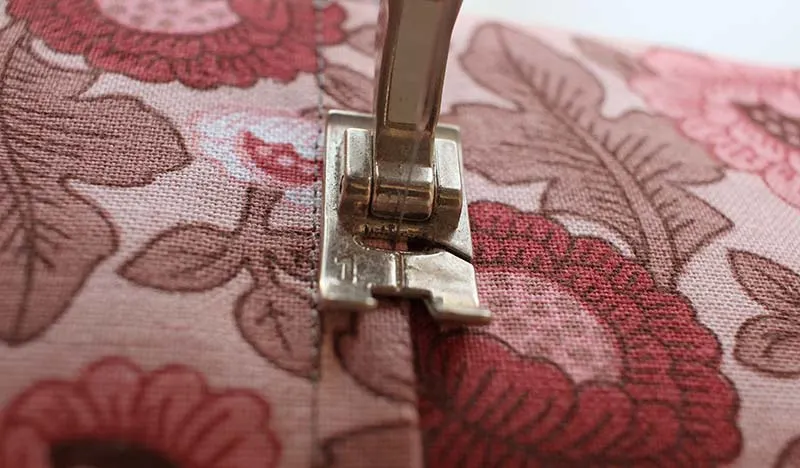
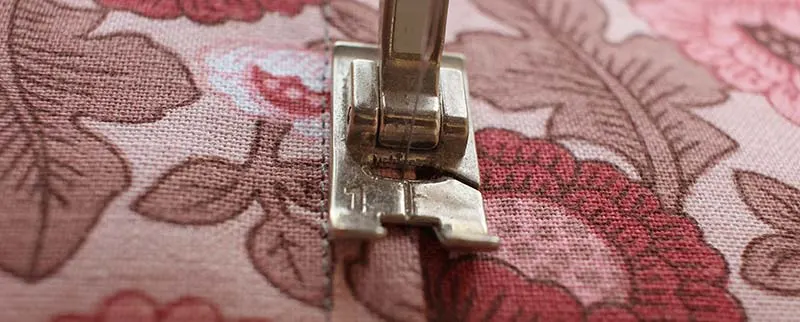
That’s it. Make sure to press the seam so that it is finished neatly.
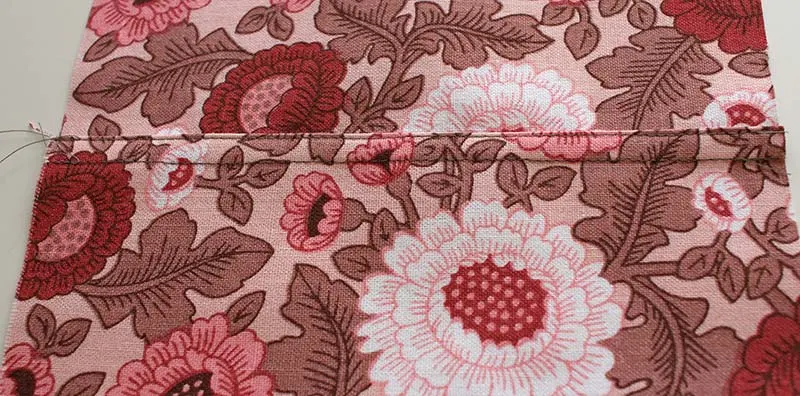
Remember, practise makes perfect, so if you’re not happy, grab another piece of fabric and create a new felled seam with your existing spare edge!
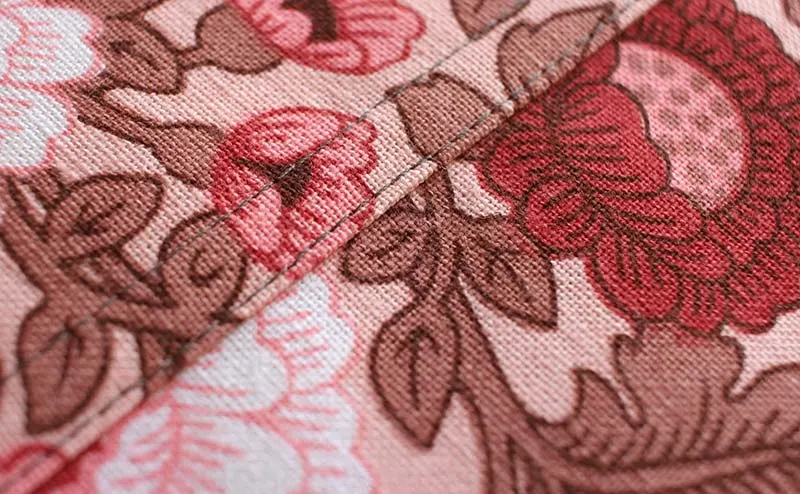

How To Sew A Run And Fell Seam
So, as I mentioned further up, a run and fell seam is the version of a flat felled seam that is sewn with the right sides of the fabric together. It is used when sewing tailored shirts.
1. Place your fabric right sides together and secure with pins.

2. Start stitching with your chosen allowance amount. I’m using 15 mm.
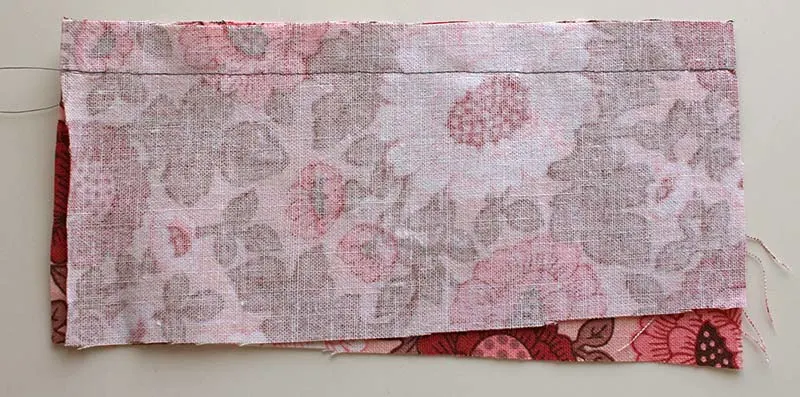
3. Press the seam allowances to one side. If you are using a run and fell seam to attach a shirt sleeve to a shirt front and back, first sew the shoulder seam and then make sure that the shirt bodice section is the smaller seam allowance, so that the sleeve allowance is the overlapping seam.

4. Trim the allowance closest to the garment to less than half. If sewing a shirt sleeve to the shirt bodice, you’ll want the shirt bodice allowance to be the allowance that is trimmed down, and you could even use pinking shears to limit the amount of bulk in this seam.
This allows the shirt sleeve allowance to wrap around the shirt bodice, and hides the ‘bulk’ of the seam inside the shirt rather than on the outside of the shirt.

5. Fold the larger allowance amount under the smaller amount, so that it wraps and hides the smaller seam allowance.

6. Secure in place with pins – it is best to do this from the right side, but be careful not to make the fabric! You may need to ‘ease’ the fabric if you are folding a curved seam from a sleeve cap around a not so curved armsyce section.
7. Sew from the right side of the fabric, so that the stitch line is using the spool thread and not the bobbin thread. This stitch line will be visible on the right side of the garment, so we need to sew it as neatly as possible.
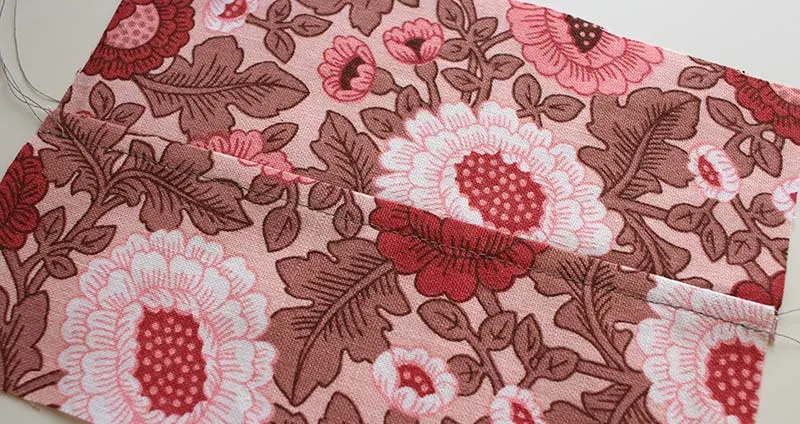


8. Finally, give it a good press. As run and fell seams are used on shirts, I would recommend using a tailors ham to press any curved seams so that there is minimal distortion and puckering.


Optional Extras
Additional items you may want to use include a felling foot / flat felled foot which is really handy if you’ll be making lots of shirts!
I haven’t used one of these myself, because I like having more control by sewing my felled seams manually, but I hear from others that they’re good.
And now, some questions you might have about flat felled seams!
What Is A Mock Flat-Felled Seam?
A mock flat felled seam is a faster, flatter and less bulky version of the flat-felled seam. For a mock version, you would finish one edge of your seam allowance only, and sew the two pieces together.
Trim the unfinished seam down and then – after pressing into place! – stitch the finished seam down from the right side.
You still have that line of visible stitching on the right side, but when turned over, you will see that the unfinished seam allowance is hidden by the stitched down finished seam allowance.
What Is The Difference Between A French Seam And A Flat Felled Seam?
A flat-felled seam is an enclosed seam like a French seam, and both require two lines of stitching, though that is where the similarities end.
As noted in this French seam tutorial, a flat felled seam is a seam that lies flat while a French seam kind of ‘hangs’ within the garment.
What Are Closed Seams Used For?
Closed seams are used to keep the raw edge of fabric tucked away to prevent fraying, and to keep things tidy. Sometimes, it doesn’t make sense to add facing and lining to a garment, and enclosing seam allowances in enclosed seams is a great way to ensure the inside of a garment has a clean finish.
What Is A Flat Fell Seam Used For?
A flat fell seam is mostly used on workwear and outerwear. With the seam allowances ‘hooking’ each other, the seam-line is strengthened, and more secure than an open seam, making it harder to ‘rip’ it.
How Do You Finish Denim Seams?

So, back in the day, denim was created as workwear. Which is why the construction of denim jeans has typically contained one of two seams:
- Flat felled seams
- Welt seams
With the advent of mass production and the ‘need’ to lower costs, you’ll notice that your shop bought denim is made more from welt seams and mock fell seams than actual flat felled seams.
This is because there is less time and fabric involved in creating a welt or mock felled seam.
A real flat felled seam is usually used on more high-end ready-to-wear denim, with both jeans and jackets being made with quality and longevity in mind.
What Is A Double Stitched Seam?
A double stitched seam is when you sew an extra stitch line parallel to the first, but within the seam allowance. This helps to add a little more stability and strength to the seam, but is only really suitable for lightweight or sheer fabrics.
If I was sewing with such fabrics, I would personally sew a French seam instead, as it is also two rows of stitching, but with a much cleaner seam finish, as can be seen in the photo below!
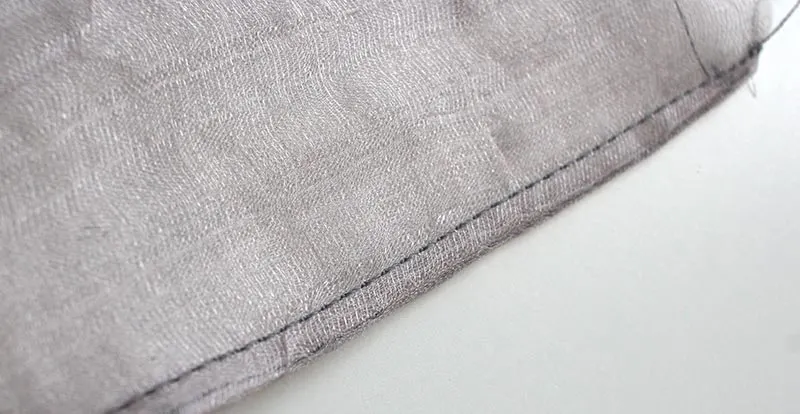
There you have it. How do your felled seams look? Are you happy with them?
Do you feel ready to take on a sewing project involving felled seams? Let me know in the comments below how it works out for you!
How To Sew A Flat Felled Seam Video Tutorial
If you enjoyed learning about the process of sewing a flat felled seam, do check out the other articles I have on different seam finishes!

Celia Tyszko
Monday 27th of May 2024
I found your classes to be very helpful. I can"t wait to start sewing using your techniques
Jude
Sunday 22nd of October 2023
That was a great tutorial! Thank you :)
Eve Tokens
Sunday 22nd of October 2023
Ah, you're very welcome Jude, glad you found it helpful!
lilly antonio
Wednesday 18th of September 2019
Hi Eve! I am from Namibia and I recently developed an interest in sewing and coming across your page was heaven sent.
Though I have never sewn in my life, I am hopeful that my interest and strong will to learn will push me to a level where I can generate income from the work I will be doing.
I just wanted to make use of this opportunity to thank you for taking time to produce this tutorial, everything you have covered is exactly what I need as a beginner I will be going through your lessons everyday because I am learning so much and the fact that you are using pictures in your lessons makes it so easy to follow especially when you use words like (Facing,Bodice,gussets, etc) that I am not familiar. thank you so much for your efforts really what you put together is helping me a lot
Eve Tokens
Thursday 3rd of October 2019
Hi Lilly! Thank you so much for taking the time to leave such a lovely comment! I am really happy to hear that you have found the tutorials helpful - I create them to encourage those new to sewing to have a go. So thank you again!
Arlene Wynn
Monday 27th of May 2019
Thank you so much for this! I've looked all over the internet and on sewing sites with little to no luck in learning how to sew seams for my linen and shirting projects.
This was easy to understand and the pictures make it very clear each step of the way.
Thank you so much for the time and effort you have put into producing this!
Eve Tokens
Monday 27th of May 2019
Ah, thank you so much for your lovely comment Arlene! I really appreciate you taking the time to let me know that you found the tutorial helpful - if there’s anything else you’ve been hunting down and haven’t yet found, please do let me know!